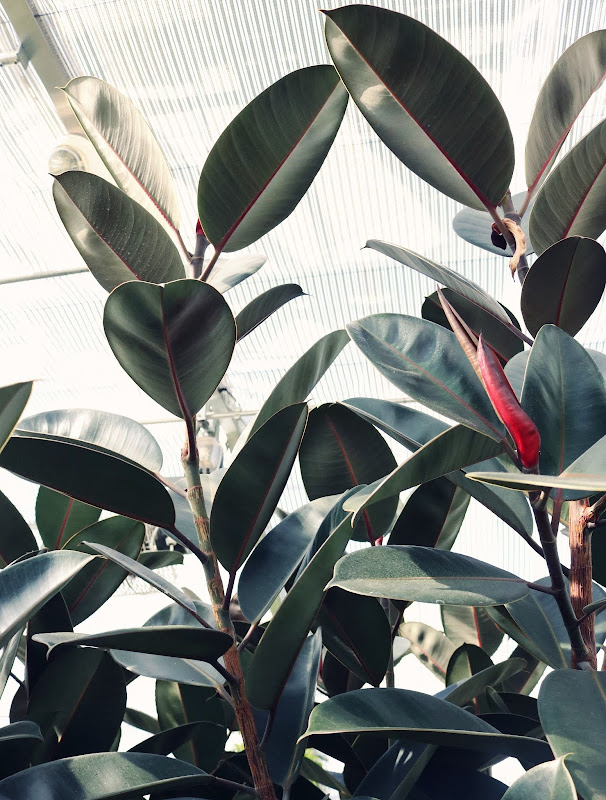 |
| Picture Courtesy: https://www.pexels.com/@scottwebb |
Tricks to have a healthy rubber plant
Soil:
This plant needs a well drained soil. For that we can take 1/3rd of any local garden soil, 1/3rd sand and 1/3rd coco peat. It does not demand much water, so excessive water will drain out and coco peat will help in retention of the moisture of the soil for a longer time.
Water:
Water is a very necessary requirement for all the plants. However, watering them in a correct amount is really important. Rubber plants demand regular watering, which means we should water them once in 3-4 days. Even if we miss out on watering them for any reason, they can forgive us till 7-10 days. But, if we continue to not water them for several days, then we may experience pale and dull leaves.
The important thing that we all should keep in mind while watering not only for Rubber plants, but for any plant is that, water them thoroughly. This implies that water all the plants till we see the excess water seeping out from the bottom of the pot. This will ensure that, each and every root of the plant has received water.
Sunlight:
This plant requires bright indirect sunlight, but keeping them in direct sunlight for a longer time can burn their leaves. The best way to provide good light is to keep a rubber plant in our balcony where it can receive either early morning sunlight from 6 AM to 9 AM or late noon light from 3 PM till evening. Or we can just keep them indoors where it can access bright indirect sunlight half of the day. Keeping this plant in direct scorching sunlight will turn out to burn their foliage.
 |
| Picture Courtesy: https://www.pexels.com/@mdsnmdsnmdsn |
Fertilisation:
Fertilisation is one essential way to improve the growth of the plants. Demand for fertiliser varies from plant to plant. When we keep a plant in a pot and water them, the soil eventually loses its nutrients. So, in order to replenish the nutrient availability of the plant, we have to regularly feed the plant with any types of fertiliser. We can use organic compost, vermicompost, cow dung compost, seaweed solution or any chemical compost as well. Using chemical compost is not highly recommended. Fertilising a handful of organic compost once a month will do a great job in keeping this plant healthy.
Pruning:
To make our rubber plant look bushier, pruning is the only solution to achieve this. Cutting the stem from its node, will help in getting the other stem, which will again allow the plant to grow sideways too. If we do not cut the stem, it will continue to grow vertically and after reaching a certain height, it will need support to grow further. Also, in studies, it's found that clipping the plant from the top is the main step to improve the growth of the plant.
Now let's have a look at the benefits it provides us.
Benefits of Rubber plant
Get a natural look to our interior:
Rubber plants have very glossy and broad leaves, which help in achieving a very different look to our house. Without pruning, this plant can grow up to 50 feet and if we prune them in the correct way, it can also convert to a well shaped tree.
Non allergic plant:
Most of the plants have a tendency to get a few people allergic due to the pollen grains present in the flower. But the rubber plant does not produce pollen grains, which helps people a lot get rid of such allergies. This is why we generally see rubber plants at the entrance of our house and offices.
 |
| Picture Courtesy: https://www.pexels.com/@scottwebb |
A great air purifier:
This plant is again a really effective air purifier. Rubber plants help in reducing the formaldehyde from our environment. Formaldehyde is a strong-smelling, colourless gas used in various household products, building materials, glues, adhesives, paper product coatings and certain insulation materials. It is also used in pressed-wood products, such as plywood and fiber board, which are used in beds, tables, furniture and cupboards. Large leaves also help in accelerating this process and purifies our surroundings.
Easy to Propagate:
Just buying one rubber plant we can eventually multiply them. For its propagation, the cutting that we’ll get from pruning, can be placed in the above mentioned soil mixture and water it thoroughly.With this, we can also gift these plants on any of the occasions like a marriage ceremony, birthday celebration and many more. This gesture will help in strengthening the relationship too.
Gifting Ideas:
We can also gift these plants on any of the occasions like a marriage ceremony, birthday celebration and many more. This gesture will help in strengthening the relationship too.
Demands less maintenance:
We have discussed above that, it needs watering once in 3-4 days and demands only bright indirect sunlight. This can be easily achieved by just keeping this near a window with a curtain and water. In case we forget to provide water, we do not have to worry about this as we have coco peat in our soil mixture, so it will keep the soil moisture for a longer period of time and grow healthy. For fertilising, we can provide a handful of organic compost once a month. This plant will not demand more than this and will bless us with bright green foliage.
A very delightful post that you have shared here. Your blog is a valuable and engaging article for us, and also I will share it with my companions who need this info about Succulents Sydney Thankful to you for sharing an article like this.
ReplyDeleteI'm glad that you found my articles useful. Thank you so much!!
Delete